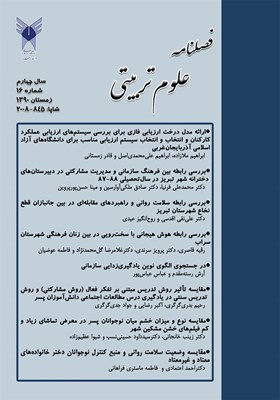Fuzzy tree model for evaluating employee performance evaluation system and Selection evaluation system for branch of University of West Azarbaijan
Subject Areas : Educational PsychologyEbrahim Mollazadeh 1 , Ebrahim Ali Mohammadi Asl 2 , Ghader Zemestani 3
1 - عضو هیئت علمی دانشگاه آزاد اسلامی واحد، ماکو، ایران
2 - کارشناسی ارشد مدیریت صنعتی دانشگاه آزاد اسلامی واحد تبریز، تبریز، ایران
3 - دانشجوی دکتری مدیریت دانشگاه قاضی آنکارا، آنکارا، ترکیه
Keywords: algorithm, Performance Appraisal, Antropy, Decision tree, nowledge base,
Abstract :
This study evaluates the fuzzy tree model to evaluate employee performance evaluation systemand Selection evaluation system for the University of West Azarbaijan units has been done.The study staff units are the University of West Azarbaijan province. In this discourse, in order to prevent the effects of the unfavorable appraisal system in west Azerbaijan Branches of Islamic Azad University, it has been intended to present a model of fuzzy tree for investigating the methods of the performance appraisal of the employees. on the basis of this model, the right performance appraisal method for each sector will be chosen. First, the researcher recognize the effective factors in identifyiny the method of the performance appraisal, then by using these factors the performance oppraisal of employees are investigated. In this case, the viewpoints of professors and the experts of human resources management are being used. By using the obtained knowledge from the experts of humsn resources management, knowledge base is created and by using knowledge base and algorithm and fuzzy sets, the model of fuzzy tree is offered. Then by distributing the guestionnaire, the values of each variable (the effective factorse in identifying the performance appraisal method) for each sector are identified. In the end, by using these obtained values, the priority of the methods of performance appraisal for each sector in identified. At the next step, by using the fuzzy multi-criterion decision making, the researcher identifies the priority of selecting the appraisal methods for each of these sectors on the basis of decision value
منابع
آرمسترانگ، مایکل (1387)، مدیریت استراتژیک منابع انسانی، ترجمه سید محمد اعرابی و داوود ایزدی، انتشارات دفتر پژوهشهای فرهنگی.
آذر، عادل (1388)، علم مدیریت فازی، مرکز مطالعات مدیریت و بهرهوری ایران، چاپ دوم.
ابطحی، حسن (1386)، مدیریت منابع انسانی، موسسه تحقیقات و آموزش مدیریت، تهران.
اورعی یزدانی، بهرام(1389)، مروری انتقادی بر ارزیابی عملکرد و نحوه اعمال آن در سازمانها با تأملی بر برخی از سازمانهای ایران، نشریه کمال مدیریت شماره 11.
الماسی، حسن (1384)، نگرش جدید در مدیریت منابع انسانی از ارزیابی عملکرد تا مدیریت عملکرد، تدبیر شماره 86 .
بوجادزیف، جرج (1387)، منطق فازی و کاربردهای آن در مدیریت، ترجمه سید محمدرضا حسینی، انتشارات ایشلیق.
جزایری، سید احمد (1387)، ارزیابی عملکرد در سازمانها، نشر نی.
حقیقی، محمدعلی، رعنایی، حبیب الله(1386)، بهرهوری نیروی انسانی- ارزشیابی عملکرد کارکنان، انتشارات ترمه.
زاهدی، مرتضی( 1388)، تئوری مجموعههای فازی و کاربردهای آن، نشر کتب دانشگاهی، چاپ اول.
Beldwin,j.f, dong(walter)xie.,(2006), simple fuzzy logic rules based on fuzzy decision tree for classification and predication problem, department of engineering mathematics, faculty engineering, university.
Hunt. John., (2005), decision trees for decision support- systems
http://www. Jaydeetechnology,co.ir
Machacha, L.L., Bhattacharya, P., (2008). A fuzzy logic-based approach to project selection. IEEE Transactions on Engineering Management 47 (1), 65–73.
Roberts S. Kaplan & David P. Norton, (1996), using the Balanced scorecard as a strategic management system, Harvard Business Review Reprint /107.
Kerre, E,. (2007), Introduction to the basic principles of fuzzy set theory and some of its applications, Communication and cognition, Blandijnberg 2, 900 .


